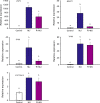Canopy light cues affect emission of constitutive and methyl jasmonate-induced volatile organic compounds in Arabidopsis thaliana
- PMID: 23845065
- PMCID: PMC4283982
- DOI: 10.1111/nph.12407
Canopy light cues affect emission of constitutive and methyl jasmonate-induced volatile organic compounds in Arabidopsis thaliana
Abstract
The effects of plant competition for light on the emission of plant volatile organic compounds (VOCs) were studied by investigating how different light qualities that occur in dense vegetation affect the emission of constitutive and methyl-jasmonate-induced VOCs. Arabidopsis thaliana Columbia (Col-0) plants and Pieris brassicae caterpillars were used as a biological system to study the effects of light quality manipulations on VOC emissions and attraction of herbivores. VOCs were analysed using gas chromatography-mass spectrometry and the effects of light quality, notably the red : far red light ratio (R : FR), on expression of genes associated with VOC production were studied using reverse transcriptase-quantitative PCR. The emissions of both constitutive and methyl-jasmonate-induced green leaf volatiles and terpenoids were partially suppressed under low R : FR and severe shading conditions. Accordingly, the VOC-based preference of neonates of the specialist lepidopteran herbivore P. brassicae was significantly affected by the R : FR ratio. We conclude that VOC-mediated interactions among plants and between plants and organisms at higher trophic levels probably depend on light alterations caused by nearby vegetation. Studies on plant-plant and plant-insect interactions through VOCs should take into account the light quality within dense stands when extrapolating to natural and agricultural field conditions.
Keywords: Arabidopsis thaliana; herbivory; light quality; phytochrome; shade avoidance; volatile organic compounds (VOCs).
© 2013 The Authors. New Phytologist © 2013 New Phytologist Trust.
Figures








Similar articles
-
Red:far-red light conditions affect the emission of volatile organic compounds from barley (Hordeum vulgare), leading to altered biomass allocation in neighbouring plants.Ann Bot. 2015 May;115(6):961-70. doi: 10.1093/aob/mcv036. Epub 2015 Apr 7. Ann Bot. 2015. PMID: 25851141 Free PMC article.
-
A genetically-based latitudinal cline in the emission of herbivore-induced plant volatile organic compounds.J Chem Ecol. 2013 Aug;39(8):1101-11. doi: 10.1007/s10886-013-0309-9. Epub 2013 Jul 26. J Chem Ecol. 2013. PMID: 23888386
-
Volatile emissions from an odorous plant in response to herbivory and methyl jasmonate exposure.J Chem Ecol. 2006 Apr;32(4):725-43. doi: 10.1007/s10886-006-9030-2. Epub 2006 May 12. J Chem Ecol. 2006. PMID: 16718568
-
The role of volatiles in plant communication.Plant J. 2019 Dec;100(5):892-907. doi: 10.1111/tpj.14496. Epub 2019 Sep 19. Plant J. 2019. PMID: 31410886 Free PMC article. Review.
-
Molecular plant volatile communication.Adv Exp Med Biol. 2012;739:17-31. doi: 10.1007/978-1-4614-1704-0_2. Adv Exp Med Biol. 2012. PMID: 22399393 Review.
Cited by
-
Synergism in the effect of prior jasmonic acid application on herbivore-induced volatile emission by Lima bean plants: transcription of a monoterpene synthase gene and volatile emission.J Exp Bot. 2014 Sep;65(17):4821-31. doi: 10.1093/jxb/eru242. Epub 2014 Jun 13. J Exp Bot. 2014. PMID: 25318119 Free PMC article.
-
Effect of Light Availability on the Interaction between Maritime Pine and the Pine Weevil: Light Drives Insect Feeding Behavior But Also the Defensive Capabilities of the Host.Front Plant Sci. 2017 Aug 29;8:1452. doi: 10.3389/fpls.2017.01452. eCollection 2017. Front Plant Sci. 2017. PMID: 28912787 Free PMC article.
-
Light-Engineering Technology for Enhancing Plant Disease Resistance.Front Plant Sci. 2022 Feb 17;12:805614. doi: 10.3389/fpls.2021.805614. eCollection 2021. Front Plant Sci. 2022. PMID: 35251062 Free PMC article. Review.
-
Increased Plant Quality, Greenhouse Productivity and Energy Efficiency with Broad-Spectrum LED Systems: A Case Study for Thyme (Thymus vulgaris L.).Plants (Basel). 2021 May 12;10(5):960. doi: 10.3390/plants10050960. Plants (Basel). 2021. PMID: 34065972 Free PMC article.
-
Dynamic environmental interactions shaped by vegetative plant volatiles.Nat Prod Rep. 2023 Apr 26;40(4):840-865. doi: 10.1039/d2np00061j. Nat Prod Rep. 2023. PMID: 36727645 Free PMC article. Review.
References
-
- Baldwin IT, Zhang Z-P, Diab N, Ohnmeiss TE, McCloud ES, Lynds GY, Schmelz EA. Quantification, correlations and manipulations of wound-induced changes in jasmonic acid and nicotine in Nicotiana sylvestris. Planta. 1997;201:397–404.
-
- Ballaré C. Keeping up with the neighbours: phytochrome sensing and other signalling mechanisms. Trends in Plant Science. 1999;4:201. - PubMed
-
- Ballaré CL. Illuminated behaviour: phytochrome as a key regulator of light foraging and plant anti-herbivore defence. Plant, Cell & Environment. 2009;32:713–725. - PubMed
-
- Ballaré CL, Scopel AL, Sánchez RA. Far-red radiation reflected from adjacent leaves: an early signal of competition in plant canopies. Science. 1990;247:329–332. - PubMed
Publication types
MeSH terms
Substances
LinkOut - more resources
Full Text Sources
Other Literature Sources

